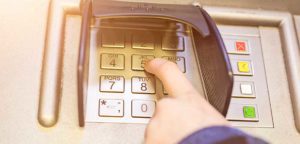Skimmers are small devices that scammers attach to a legitimate credit or debit card reader. The skimmer steals your personal information through your credit card’s magnetic strip or a fake keypad that records the keystrokes of your PIN. Some skimmers are so small and discreet that you might not even spot anything amiss.
Skimming occurs most frequently at locations like gas stations, self-checkout lanes and ATMs. Criminals then use your stolen information to make purchases or withdraw cash. Because your physical card is never lost or stolen, the theft often goes undetected until a statement or overdraft notice arrives.
Want a surprising statistic? A skimmer can be attached to a card reader in about 30 seconds. If you think about how long a gas station pump sits unattended overnight, it’s not that unlikely to see how a thief can quickly get away with installing a skimmer.
WHAT DOES A CREDIT CARD SKIMMER LOOK LIKE?
Brian Krebs, one of the world’s foremost experts on the topic, offers pictures of credit card skimmers, which have become smaller and more discreet through the years. Advances in Bluetooth technology are making it easy for criminals to walk up to the skimmers they installed and discreetly transfer data in seconds.
Some telltale signs of a skimmer are:
- Mismatched colors or materials
- Parts that stick out or overlap in an odd way
- Graphics that don’t align with the rest of the machine
- Parts that wiggle, shift or move when you push them (such as the card reader or pinpad)
HOW TO PREVENT SKIMMING
Here’s the good news: Police and businesses are catching more skimmers in the act. Additionally, new technology like chip cards and near-field communication payments (like Apple Pay and Android Pay) are more secure than magnetic stripe readers, making it harder for thieves to swipe your personal info.
Still, skimmers are out there – and it’s important to know how to protect yourself. Follow these tips:
- Take a look around. If something seems off, compare it to nearby payment terminals or ATMs before you swipe your card. For example, if the other card readers are black but yours is bright yellow, that could be a sign a skimmer was installed.
- Opt for high-traffic locations. Skimmers are illegal, so criminals don’t want to get caught installing them. With that in mind, you might be more likely to encounter a skimmer at a more secluded location. For example: Opt for indoor ATMs that stand within sight of security cameras, such as those at banks or grocery stores. Be cautious when using standalone ATMs on isolated sidewalks.
- Wiggle the card reader before you use it. Before using an ATM or card reader, make sure there aren’t any devices attached to it. Everything should feel sturdy with no loose parts, especially the card reader and pinpad.
- Cover your hand as you type your PIN. At ATMs, skimmers may place a tiny “pinhole” camera within view of the keypad to steal your PIN. This will help keep a camera from catching a view of what you’re typing.
Finally, if you do spot something malicious – make sure to let the store manager or bank staff know right away.
WHAT SHOULD YOU DO IF YOUR CREDIT CARD IS COMPROMISED?
Even by taking the best precautions, there’s no foolproof way to avoid identity theft. That’s why it’s worth talking to your Joseph W. McCartin Insurance Inc. agent ahead of time about how to add Identity Recovery Coverage to your homeowners insurance policy.
Covered costs include lost wages, costs of supervising children or elderly relatives while you sort things out, certain legal fees, fees for refilling applications and more. The coverage also provides the services of an identity recovery case manager.
To learn more and get a free quote, contact Joseph W. McCartin Insurance Inc.
by Erie Insurance

